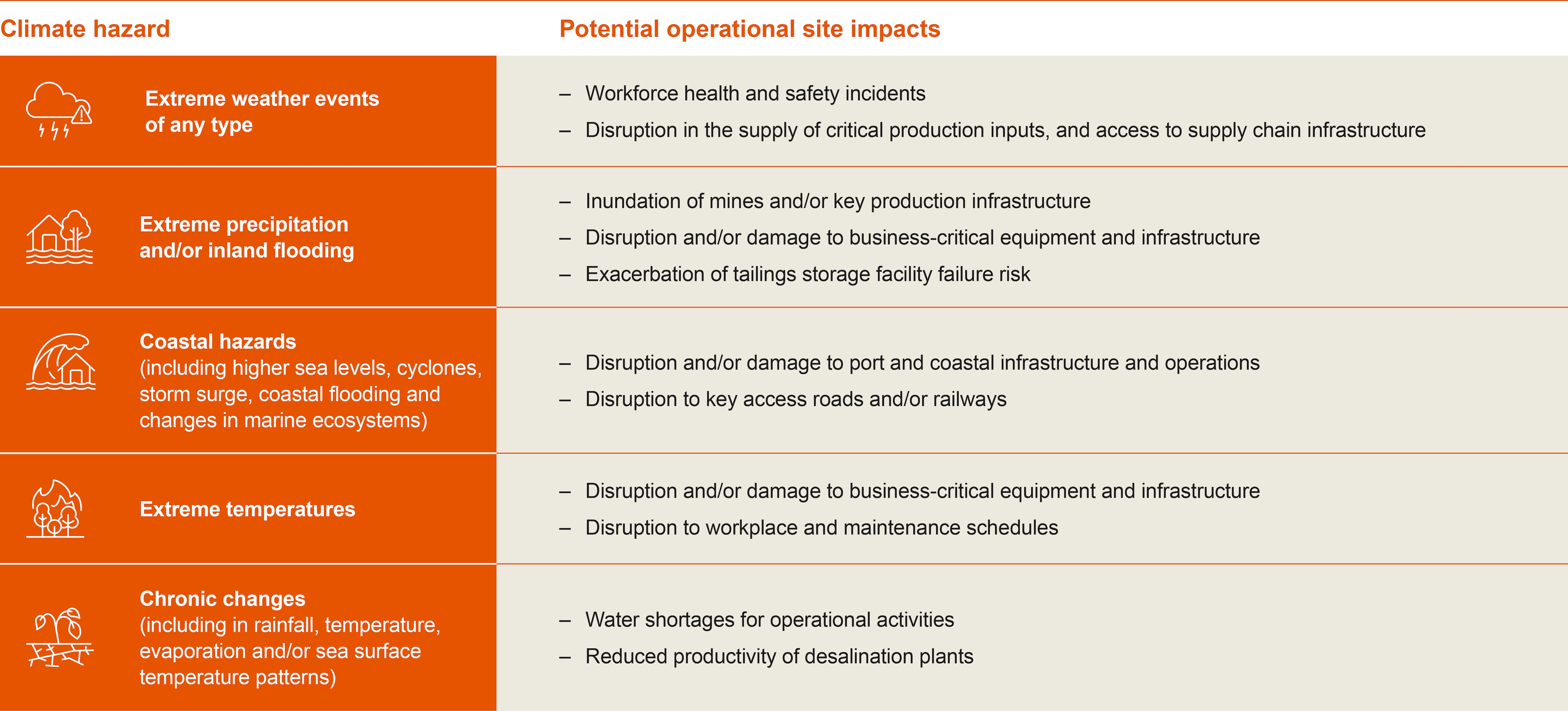Our latest disclosures
Our most recent climate-related disclosures can be found in the BHP Annual Report 2025, Operating and Financial Review 9.8 – Climate change. Refer also to the BHP Climate Transition Action Plan 2024 for BHP’s climate change strategy, subject to updates of certain aspects of our assumptions and plans in the BHP Annual Report 2025, Operating and Financial Review 9.8 – Climate change.
Our approach
A changing climate can exacerbate and trigger physical climate-related risks, which include:
- Acute physical climate-related risks: extreme climatic events, such as floods, cyclones and heatwaves, that may become more severe and/or more frequent because of a changing climate
- Chronic physical climate-related risks: the incremental worsening of conditions, such as the gradual increase in the number of extreme heat days over the years, or rising sea levels
The mining sector is exposed to both acute and chronic physical climate-related risks because of its remote outdoor operations with labour and physical capital exposed to the elements, and because of its dependency on global value chains. The long lives of mining assets mean they could encounter deteriorating conditions in later decades. Geographically dispersed sites and value chains increase the diversity of physical climate-related impacts we may face.
We are undertaking studies to assess our exposure to physical climate-related risks that draw on science-based climate data (described under Climate modelling). We also continue to progress our work to build further climate resilience, where appropriate, in asset planning, projects, operations and closure. Our approach to evaluating our operational physical climate-related risks is illustrated in the Our approach to physical climate-related risk diagram below.
Our approach to physical climate-related risk

Climate modelling
Our climate hazard dataset (CHD) covering our operated assets and some key value chain locations enables us to deepen our understanding of our physical climate-related risk exposure, alongside local observational data and other sources of climate projections. In FY2025, we developed an online platform to make the CHD more readily accessible internally. The dataset covers more than 20 climate-related hazards and includes a baseline and projections for four future time horizons across this century, for the following scenarios, based on Shared Socioeconomic Pathways (SSPs) used by the Intergovernmental Panel on Climate Change:1
- Low-case: estimated average global temperature increase of 1.8°C by CY2100 (SSP1-2.6)
- Mid-case: estimated average global temperature increase of 2.7°C by CY2100 (SSP2-4.5)
- High-case: estimated average global temperature increase of 4.4°C by CY2100 (SSP5-8.5)
1. Table SPM.1, Summary for Policymakers. In: Climate Change 2021: The Physical Science Basis. Contribution of Working Group I to the Sixth Assessment Report of the Intergovernmental Panel on Climate Change. IPCC, CY2021.
Risk Studies
In FY2025, our operated assets (excluding New South Wales Energy Coal (NSWEC), legacy assets and Western Australia Nickel (WAN)) used the CHD to undertake or continue prior-year physical climate-related risk analysis. This included risk and impact transmission channel analysis and assessment of potential safety, production and cost impacts, informed by technical studies such as flood modelling, water balance modelling and various quantitative assessments. The first stage of our physical climate-related risk analysis has focused on our operated assets that are currently producing (during FY2025). WAN was excluded from further analysis in FY2025 due to its period of temporary suspension. For NSWEC and legacy assets, we have been focusing on post-mining and closure phases, updating risk profiles and adaptation plans based on our latest knowledge of climate-related risks and potential impacts. We intend to continue this work in FY2026.
The table Potential physical climate-related risks at our operated assets and in their value chains below shows the physical climate-related risks we have identified in studies to date as having potential to impact on our operated assets and value chains.
Potential physical climate-related risks at our operated assets and in their value chains

Risk controls
We have a range of existing controls in place for extreme weather-related risks. These include weather-related hazard detection, monitoring and associated weather preparation, emergency management plans and personnel trained in emergency response. We are committed to conforming with the Global Industry Standard on Tailings Management, including its climate-related requirements. We also employ measures to guard against potential equipment failure or inefficiencies during extreme weather. We undertake contingency planning for disruptions to our operated asset and value chain, including for scenarios caused by climate-related impacts.
As our understanding of physical climate-related risks at our operated assets evolves, we make updates to our risk profile and asset-level adaptation plans where relevant. For example, we have been progressing embedment of climate-adjusted risks into flood mitigation structure designs at Copper South Australia and BHP Mitsubishi Alliance (BMA), and building climate projections into wet weather budget and water balance modelling for strategic water planning at BMA. We expect to continue to identify adaptation opportunities to further protect value and enable growth as we progress our ongoing physical climate-related risk studies.

Sustainability case studies, organisational boundary, definitions and disclaimers, and downloads
Prior year versions of some of the listed documents are available on the Past reports page.-
BHP Annual Report 2025
pdf
17068205

-
Sustainability reporting organisational boundary, definitions and disclaimers
pdf
170075

-
Límite organizativo de los informes de sostenibilidad, definiciones y descargos de responsabilidad
pdf
234993

-
BHP ESG Standards and Databook 2025
xlsx
2541694

-
BHP Group Modern Slavery Statement 2025
pdf
7308735

-
BHP GHG Emissions Calculation Methodology 2025
pdf
1124687

-
BHP Climate Transition Action Plan 2024, subject to updates of certain aspects of our assumptions and plans in the BHP Annual Report 2025, Operating and Financial Review 9.8 – Climate change
pdf
8480121

-
Global Industry Standard on Tailings Management - Public Disclosure 2025
pdf
25537144

-
Tailings Storage Facility Policy Statement 2023
pdf
73457

-
Case studies

